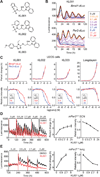Identification of small molecule activators of cryptochrome
- PMID: 22798407
- PMCID: PMC3589997
- DOI: 10.1126/science.1223710
Identification of small molecule activators of cryptochrome
Abstract
Impairment of the circadian clock has been associated with numerous disorders, including metabolic disease. Although small molecules that modulate clock function might offer therapeutic approaches to such diseases, only a few compounds have been identified that selectively target core clock proteins. From an unbiased cell-based circadian phenotypic screen, we identified KL001, a small molecule that specifically interacts with cryptochrome (CRY). KL001 prevented ubiquitin-dependent degradation of CRY, resulting in lengthening of the circadian period. In combination with mathematical modeling, our studies using KL001 revealed that CRY1 and CRY2 share a similar functional role in the period regulation. Furthermore, KL001-mediated CRY stabilization inhibited glucagon-induced gluconeogenesis in primary hepatocytes. KL001 thus provides a tool to study the regulation of CRY-dependent physiology and aid development of clock-based therapeutics of diabetes.
Figures




References
Publication types
MeSH terms
Substances
Grants and funding
LinkOut - more resources
Full Text Sources
Other Literature Sources
Molecular Biology Databases

